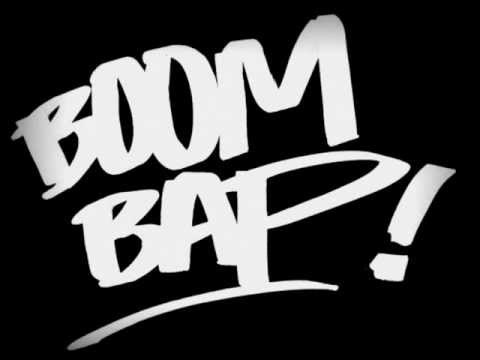Boom Bap
Boom Bap: A brief history of the subgenre and yes, it means more than just old dusty Hip Hop.
SUMMARY
Boom Bap is a style/sub-genre of hip hop characterized by hard-hitting drums, usually containing the kick drum/snare drum/hi-hat combination rather than claps, snaps, TR-808 bass drums, cowbells, shakers, and various other percussion sounds used for rhythm. It became popular in the 1980s and remained a popular style of hip hop throughout the 1990s. Its roots are directly linked to the original hip hop culture traditions of rapping over breakbeats, scratching, and blending older records together to create new music.
Boom Bap separated itself from previously commercially released Hip Hop music by replacing a full polished sound with a stripped-down beat. Boom Bap songs did not have progression, melody, singing, or extensive percussion often found in the emerging electronic music. Instead it relied on realistic drum patterns, sampling, scratching, and advanced rapping to provide a low-tech sound that represented the inner city.
By the late 90s, other styles of hip hop pushed Boom Bap into the underground but it is still viewed as the foundation of hip hop music with many fans still viewing it as “real” hip hop.
SOUND AND CONTENT
Beat
Boom Bap beats are supposed to reflect the sounds of the streets and connecting to the original breakbeat sound of hip hop formed in the 1970s. The breakbeats would be parts of songs where the melody and additional instrumentation was taken out and the drums would play by itself. The breakbeat would be the part the DJ loops and MC raps over.
The drums are often a loop of sampled breakbeat but may also come from a beat machine used to replicate real drums or a combination of the two. Sometimes two different kick drums or snares would be layered on top of each other to put an even heavier drum sound. The one and three count on the beat would typically have a kick drum and the two and four count of the beat would have a snare. These drums contained swing which is defined as the addition of tiny delays to every other hit of a beat. This gives the drums a natural sound of a real human drummer to give groove to the track. Tracks are typically between 80 to 120 bpm but can certainly be slower or faster.
In contrast to Boom Bap, Electrohop had various drum patterns, would feature constant snares or hi-hats in 32nd notes, and have percussion sounds such as claps, snaps, TR-808 bass drums, cowbells, shakers, and other sounds not typically included in physical drum sets.
Vocals
Since there is typically no melody or singing in these songs, the rap performance and DJ scratching are the main focus. With the Boom Bap beats being counterculture to the world of R&B and pop, the rapping also tends to fit the aggressive street aesthetic described as Hardcore Rap. In the 1980s Boom Bap music and hardcore rap would have primarily been synonymous, but today a variety of rappers may use boom bap beats.
The rapping stems from the original hip hop culture that featured battling, cyphers, and freestyling. Often the rapping focuses on showcasing skills which can be done with a variety of techniques. This may include wordplay, extended metaphors, multisyllabic rhyming, internal rhyming, dissing competitors, or just other creative ways to brag. Some artists such as Public Enemy and Paris, focused on making political and socially conscious music. Storytelling was also common in this type of music, as the sheer quantity of words in a hip hop song allows for a more detailed story to be put into song than most other music genres. As Gangsta Rap developed in the 1980s, stories about life in the street started containing cusswords, gunplay, graphic sex, drugs, and generally more controversial subject matter. Also, West Coast music about pimp culture and gang culture grew in popularity in the 1980s, this influenced east coast rap music to become edgier as well.
Additional Features
Scratching
Scratching, sometimes referred to as scrubbing, is a DJ and turntablist technique of moving a vinyl record back and forth on a turntable to produce percussive or rhythmic sounds. A crossfader on a DJ mixer may be used to fade between two records simultaneously. In hip hop culture, scratching is one of the measures of a DJ’s skills. In recorded hip hop songs, scratched “hooks” often use portions of other songs. Boom Bap beats typically include scratching to some extent and often will have scratched hooks.
Sampling
In music, sampling is the reuse of a portion or sample of a sound recording in another recording. Samples may comprise rhythm, melody, speech, or other sounds. They are usually integrated using hardware (samplers) or software such as digital audio workstations. The 1988 release of the first Akai MPC, an affordable sampler with an intuitive interface that made sampling accessible to a wider audience.
Sampling is a foundation of hip hop music, as the original breakbeats used were of older records. In order to create new beats, the DJs would play two breakbeats at once or scratch on one breakbeat while letting the other play. Samplers allowed DJs to take these techniques to another level and mix different sounds from multiple records or multiple parts of a song into a beat.
Typically Boom Bap producers sample funk, jazz, and soul from the 1970s but certainly is not limited to this. After the 1970s most popular music used more electronic production so Boom Bap is usually associated more with sampling from that era, however sampling live instrumentation in more modern times can produce a similar aesthetic.
Sound and Content Summary
Summary of Common Elements of Boom Bap Music
- General
- Drums and vocals are loudest – Samples often more in the background. Also, low pass filters are often used so the mix doesn’t get too bright and maintains lo-fi feel.
- BPM – Usually around 80 to 120
- Looped drums and samples with little to know build up or progression
- Boom Bap Drums
- Kick drums, snares, and hi-hats. Kick drums usually on the 1 and 3 beat to provide the “boom” and the snare on the 2 and 4 beat to provide the “bap”
- Swing – Swing added to drums to give human feel to drums.
- Layered drums – Often when combining sampled drums with drum kit drums, the drums can be layered to give a more unique deeper sound.
- Beats are often sparse to allow rappers lyrics to take focus in the music.
- Scratching – Scratched hooks or sometimes other parts of the beats.
- Sampling – Samples of 70s music and prior. Samples of music with live instrumentation
- Vocals
- Focus on lyricism. Boom Bap heavily relies on the rapper to carry the song. The content can vary but often Boom Bap songs either have more depth than average rap songs or showcase a more complex level of technique or lyrical creativity.
HISTORY
Origins
As a sub-genre boom bap is primarily a description of the production technique used for the song. The origin of the term comes from Bronx rapper T La Rock. When he was recording he would ad-lib to the drums saying “boom” for the kick drum and “bap” for the snare drum. The typical pattern heard in early rap songs went “boom-bap-boom-boom-bap.” In the early days of rap the equipment used to produce songs were very limited so drum machines didn’t include all the percussion sounds found in more modern electronic music. As a result, producers developed a production style that focused on making the most with the limited sounds of a kick drum, snare drum, hi-hat, and later on a sample. Russell Simmons’ and Rick Rubin’s Def Jam records pioneered the stripped down Boom Bap sound and launched acts such as Run DMC, Beastie Boys, LL Cool J, and Public Enemy.
Another major component to Boom Bap is sampling which was started by DJ Marley Marl. DJ Marley Marl often experimented with techniques used in electronic music and discovered that with his equipment he could record a clip of a song and then make it a button to be played into a beat he created. This allowed him to add additional drums into a beat.
Equipment
Technics SL-1200
The SL-1200 was the most influential turntable. It was developed in 1971 by a team led by Shuichi Obata at Matsushita, which then released it onto the market in 1972. It was adopted by New York City hip hop DJs such as Grand Wizzard Theodore, Afrika Bambaataa and Grandmaster Flash in the 1970s. As they experimented with the SL-1200 decks, they developed scratching techniques when they found that the motor would continue to spin at the correct RPM even if the DJ wiggled the record back and forth on the platter. Scratching is a main component in Boom Bap music.
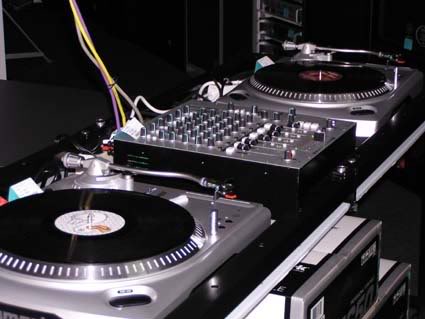
Two Turntables and a Mic setup (left).
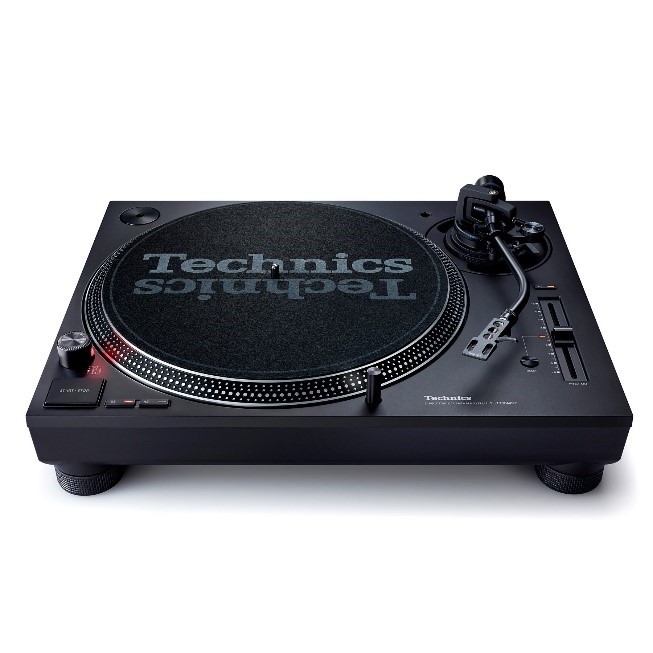
Technics SL-1200 Turntable.
Roland TR-808
The Roland TR-808 Bass (Kick) Drum is a main component in Boom Bap beats. The Roland TR-808 Rhythm Composer was a drum machine developed in 1980 and the bass drum in it was often used or sampled to be incorporated into Boom Bap beats. Although the drum sounds were considered unrealistic by critics the TR-808 became a hit for emerging electronic, dance, and hip hop genres partly due to its booming bass drum. An early hit using the TR-808 include 1982’s “Planet Rock” by Afrika Bambaataa and the Soulsonic Force. Today it has become the drum machine used on more hit records than any other.
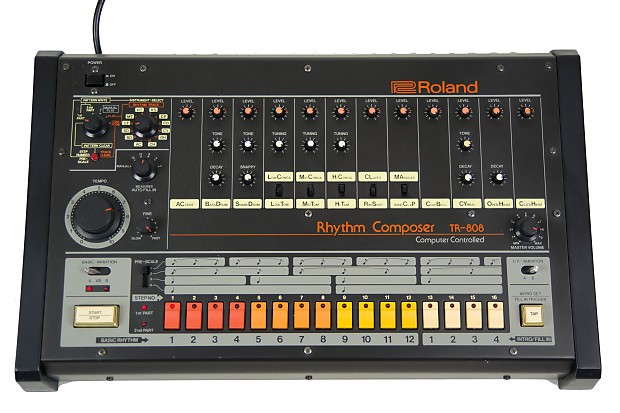
Roland TR-808 Drum Machine
Akai-S900
The Akai-S900 sampler was Akai’s first truly affordable professional digital sampler, released in 1986. Its sampling specifications were pro-quality at the time: 12-bit stereo sampling, 7.5kHz to 40kHz variable sampling rates and a maximum of 63 seconds of sample time at 7.5kHz. Up to 32 samples can be created and stored to disk along with any edit settings. This was one of the first rack-mount samplers to use a built-in disk drive. Although the drive could load sounds while you play, it was still a very slow process.
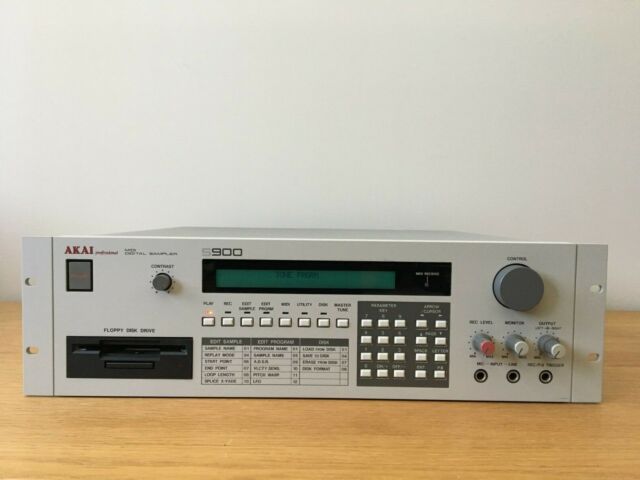
Akai-S900 Sampler
SP-1200
The E-mu SP-1200 is a drum machine & sampler combo of legendary status among old school rap and hip hop artists released in 1987. It has limited sampling specs: 26.040 kHz and 12-bit resolution. However the dirtiness of that sound was great for hip hop and house music as it reflected “old vinyl”. It features groove quantizing and a disk drive for sample storage. As an upgraded version of the 1985 SP-12, the SP-1200 focused on its coolest feature – sampling. The preset drum sounds of the SP-12 were omitted, leaving room for up to 32 user samples of your own custom sampled and edited drum sounds. The limited sampling time of the SP-1200 was overcome within the late 1980s hip hop production circles by sampling 33⅓ rpm records at 45 rpm, with an additional pitch increase, then replaying the sample from the SP-1200 at a much slower speed. This expanded the total sampling time while at the same time decreasing the resolution. By the early 1990s, nearly every working hip hop producer had adopted this technique as industry standard until the advent of newer samplers such as Akai’s MPC60, which provided higher sampling rates and more sampling time.
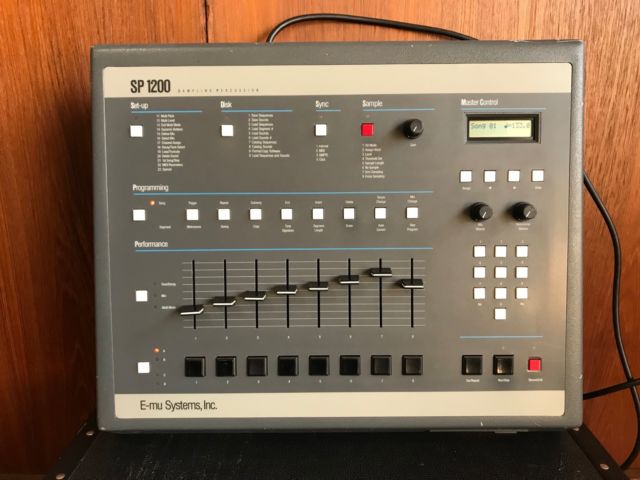
E-mu SP-1200 Drum Machine and Sampler
Akai MPC60
The Akai MPC60 is a digital sampler plus drum machine released in 1988 that opened the door for new sampling techniques. Most artists created their patterns in real-time adding drum parts to a beat-loop spontaneously creating a groove that captures the vibe. These patterns are varied and chained into a sequence. For Boom Bap it added swing in the drums so the drums sounded less electronic and more human. Whereas prior artists had sampled long pieces of music, the MPC allowed them to sample smaller portions, assign them to separate pads, and trigger them independently, similarly to playing a traditional instrument such as a keyboard or drum kit. Rhythms can be built not just from percussion samples but any sampled sound, such as horns or synthesizers. The MPC60 only allows sample lengths of up to 13 seconds, as sampling memory was expensive at the time and the developer expected users to sample short sounds to create rhythms; he did not anticipate that they would sample long loops. The MPC60 had an LCD screen and came with floppy disks with sounds and instruments.
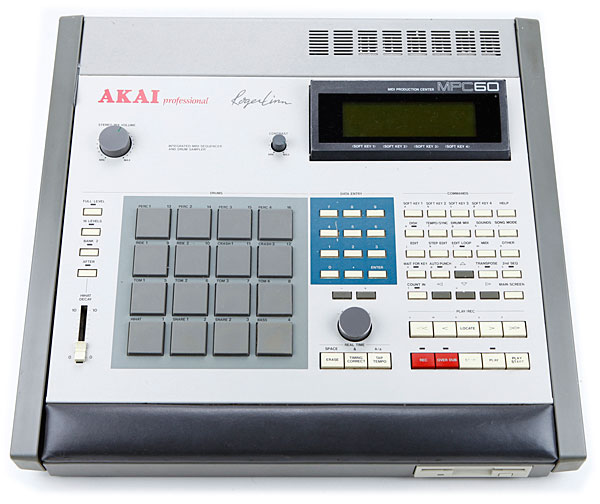
Akai MPC60 Digital Sampler and Drum Machine
Boom Bap in the 80s
By the mid 80s the Boom Bap sound had surpassed electro-hop in popularity and by the late 80s many acts had platinum sales as well. It was by far the dominant sound of the East Coast Hip Hop that featured the startup in New York as well as the scenes emerging in New England, New Jersey, and Philadelphia. California initially was dominated by Electro-hop but acts such as Ice-T, King Tee, and N.W.A. found great success with a sound more similar to the East Coast. Also, it had spread into Houston’s underground as well as heard in local hits such as “Car Freak” by the Geto Boys.
Boom Bap in the 90s
Although other subgenres of Hip Hop emerged throughout the 90s, Boom Bap remained a dominant sound throughout the decade. Producers such as DJ Premier, Pete Rock, Q-Tip, Rza, J. Dilla and others started making the sampling techniques more advanced with additional effects and chopping up multiple samples to incorporate in one song. Even many of the acts that began making crossover music, still filled much of their albums with Boom Bap tracks for their core fanbase. The 90s Boom Bap featured a smoother sound than the previous decade often favoring more smooth jazz samples instead of guitar riffs and the punk rock aesthetic. Also, due to restrictions on sampling clearances, samples were used more creatively and subtle as to avoid being caught and sued.
Mainstream Decline
Rise of Other Subgenres
Although Boom Bap was still alive and well during the 90s, other styles of hip hop carved out a big part of the market. G-Funk became a very dominant subgenre from 1992 to 1996. By the late 90s, the Dirty South had gained a lot of momentum utilizing live instrumentation and electronic production. R&B and hip hop blended much more and the shared fanbase led to making of more crossover Hip Hop and less Boom Bap.
Sampling Restrictions
As hip hop got more popular, companies started cracking down on the sampling used more often. The process of acquiring permission for a sample is known as clearance, which can be a complex and costly process. Landmark legal cases, such as Grand Upright Music, Ltd. v. Warner Bros. Records Inc in 1991, changed how samples are used. As the court ruled that unlicensed sampling constitutes copyright infringement, samples from well-known sources are now often prohibitively expensive and gaining permission is an arduous process deterring many up and coming producers from the subgenre. For producers such as DJ Premier that chop up many samples into one beat, this meant getting permission from many different sources in order to have a song cleared. Producers could still sample with permission and compensation but sometimes permission would not be granted by the original artist or the compensation requested would lead to artists believing the beat was not worth it. Due to hurdles of sampling and shifting mainstream Hip Hop sound some producers veered into different styles.
Legacy
Despite this drop, Boom Bap still serves as the general foundation of most Hip Hop music and has a strong presence in underground rap. Although not done exclusively, still to this day many popular artists continue to use the Boom Bap sound. The Pro Era collective is noted as having a sound closest to the original Boom Bap which is most commonly seen in the artist Joey Badass. Also, artists such as J. Cole and Kendrick Lamar make music heavily influenced by Boom Bap.
Similar Subgenres
Hardcore Rap – Rap characterized by anger, aggression, confrontation, and/or the uncensored reflections of street life.
Chillhop Rap – Laid back Hip Hop that can be produced with electronic techniques or in Boom Bap style that was initially derived from the smooth Hip Hop produced by J. Dilla, Pete Rock, Q-Tip, and others.
Rock Rap – Rock music featuring rapped verses and/or Hip Hop music featuring rock instrumentation whether sampled or recorded.
Jazz Rap – Hip Hop featuring jazz instrumentation whether sampled or recorded.
Hip Hop Soul – Soul singing style vocals sung over mid-tempo hip hop production
Some of the key Boom Bap rappers and rap groups
• Beastie Boys
• Boogie Down Productions
• DJ Jazzy Jeff & Fresh Prince
• Eric B. & Rakim
• Joey Badass
• Juice Crew
• Little Brother
• Public Enemy
• Run DMC
• Wu Tang


